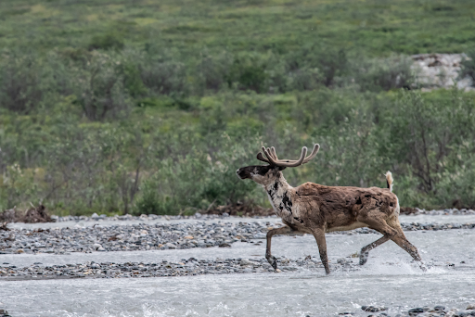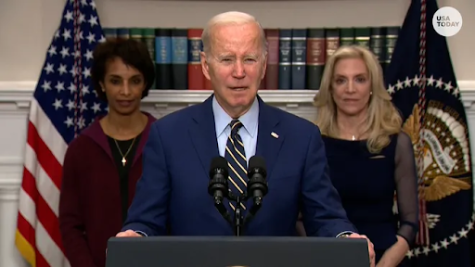The drastic impact of the Willow Project: Environmentally and politically

https://www.theguardian.com/environment/2023/mar/14/biden-president-approved-alaska-willow-project (Bryan Olin Dozier)
On Monday, March 13th, 2023, the Biden administration approved Conocophillips’ massive oil drilling project despite the onslaught of online activism against its approval. The “Willow Project” was initially presented by Conocophillips, Alaska’s largest crude oil producer, as a decade-long oil drilling project within the National Petroleum reserve of Alaska. The initiative was originally approved by the Trump administration in 2020 but the project received a major amount of scrutiny from Americans as Biden transitioned into office based on his strong stance against federal drilling. Not only has the Willow project had a huge impact on the political climate, but the expected environmental impact is potentially irreversible and a huge step backwards in the fight for climate justice.
The Environmental Impact

(Alexis Bonogofsky)
The arctic environment of Alaska has been subject to major environmental change, as it has warmed four times as fast as the rest of the planet since 1979. Protesters of the Willow Project worry about Conocophillips’ initiative, dubbed the “carbon bomb”, and how it will exacerbate an already concerning environmental situation.
The Willow Project is currently predicted to produce 180,00 barrels of oil a day through the project’s 30 year lifespan. Looking at the project in terms of carbon footprint, the New York Times reports that the Willow Project will produce over 280 million metric tons of carbon emissions which is 9.2 metric tons of carbon pollution a year. As well as the major emission of greenhouse gasses, the North Slope of Alaska is one of the last unspoiled wilderness areas in the country, and the infrastructure would destroy crucial ecosystems in the North slope as well as the food security of local indigenous communities.
“Our people feed their families with traditional subsistence activities like fishing and hunting caribou, moose, birds, and more,” mayor of the city closest to the Willow Project, Rosemary Ahtuangaruak explains in an interview with New Republic.
To prevent permafrost thaw, Conocophillips has said that they would insert “chillers” in the ground that will keep the ground and artificially excrete more oil which, as Stop Willow News reports, will just make the climate situation worse.
So far, environmental justice groups such as Greenpeace, the Alaska Wilderness League, Earthjustice and more have filed a lawsuit against Conocophillips’ initiative; their claims are based on the National Environment Protection Act, which requires federal agencies to thoroughly assess the environmental effects of proposed major federal actions prior to making decisions. CNN reports that if these environmental groups secure an injunction before the start of Willow in April, they could delay construction for at least a year.
The Political Impact

(Anastasiia Riddle)
The Biden administration’s stance on environmental justice has been clear from the time of the campaign. President Biden even stated in one of his campaign speeches, “No more drilling on federal lands, period. Period, period, period.” So you can imagine the American people’s surprise when a drilling project as massive as Willow managed to get a stamp of approval from the Biden administration. Despite over 1 million letters sent to the White House protesting the project, the administration claimed that their hands were tied, CNN reports.
For over two decades, Conocophillips has held leases for the drilling site in the North Slope. The current administration argued that rejecting the Willow Project would trigger heavy legal action and that could cost the federal government as much as 5 billion dollars. The Biden administration has also tried to cut the environmental impact of Willow down by reducing the number of drilling pads from five to three, which allows for only 90% of the oil to be drilled. Alaska’s Senator Lia Murkowski goes as far as to say that the Willow Project is in line with the environmental goals of the Biden administration, calling the initiative “meticulously planned, socially just, and environmentally sound.”
Murkoski’s claim rests mostly on the basis that Willow will provide over 25,000 jobs for Alaskan residents and millions of dollars of revenue. However, a recent article by the Anchorage Daily News points out the gaps in the budget for Willow, stating that the current plan would “spur a cumulative loss of more than $1 billion in oil-production tax revenue over about 10 years.” Not to mention that in March of 2022 an oil spill from one of Conocophillips’ oil fields caused 300 employees and some residents of the nearby Indigenous village to evacuate, according to Stop Willow News. While the incident report places blame on a shallow gas zone, their past project mistakes adds to the growing list of worries for Willow protesters.
With the hashtag #Stopwillow trending on all platforms and a mass uprising of online activism against Willow in the wake of its approval, the Democratic party can expect to have lost a good amount of young people’s vote. All eyes are on the Biden administration as young people and Indigenous communities fight for an equal chance at living a full life on a healthy earth.
jy/ac/ew
For more breaking news and photos, follow The Wingspan on Instagram and Twitter @CHSWingspan.


